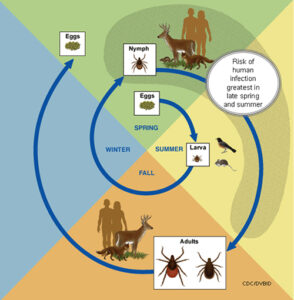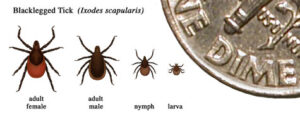Ask a Naturalist: Ticks, Tickborne Diseases, and Thinking Beyond Safety Precautions
Ticks and Tickborne Diseases
We have all read and heard about ticks at some point in life, regardless of whether we regularly spend time outdoors. Some of us may even have gotten tick-bites a few times and have received a preemptive treatment because the tick found latching onto us was engorged enough to make us anxious. Most of us are lucky not to get tickborne diseases such as Rocky Mountain spotted fever or Lyme disease.
Ticks are external parasites related to spiders and scorpions in the arthropod group. Arthropods are invertebrates with jointed legs, an exoskeleton (outer protective shell), and a segmented body. The number of legs and body segments depends on the arthropod group of the animal and its body structures. For example, insects have 3 body segments and 6 legs, spiders and mites have 2 body segments (fused head and thorax + abdomen) 8 legs and centipedes and millipedes usually have more than 15 body segments and equal or more legs.
Ticks go through four stages in their life cycle: the egg, the larva, the nymph, and the adult stages. Ticks developmentally advance to the subsequent stage only after a successful blood meal. Humans become victims of their “questing” (blood meal seeking) behavior when we pass through shrubs and leaf litter where ticks usually hide. Although ticks are active from spring through summer, tick bites can occur throughout the year.
Figure 1. This diagram shows the lifecycle of blacklegged ticks that can transmit Lyme disease. Source: The CDC- Lifecycle of Blacklegged Ticks

Figure 2. Common ticks of Eastern North America. American dog tick (left), Lone star tick (right) and Blacklegged tick (bottom). Source- Centers for Disease Control and Prevention



Most of the ticks found in North America are hardbacked ticks precisely because they have hard-shelled back. Although more than 700 hardbacked ticks are found around the world, about 60 are known to bite humans and transmit many diseases, which sometimes can cause chronic illnesses and lasting lifelong symptoms for infected individuals. The three most common ticks: American dog tick, Black-legged tick, and Lone-star tick, are responsible for more than 15 tickborne diseases in the US. Ticks are super vectors, carrying one or more disease-causing pathogens, sometimes as many as six. American dog ticks are known to spread Rocky Mountain spotted fever and tularemia. Black-legged ticks are responsible for spreading anaplasmosis, babesiosis, ehrlichiosis, Lyme disease, Borrelia miyamotoi disease, and Powassan virus disease. A lone-star tick bite can cause ehrlichiosis, Heartland virus disease, southern tick-associated rash illness (STARI), Bourbon virus disease, and tularemia. Indeed, tickborne diseases are many and confusing unless you happen to be a tick expert who studies and treats these diseases. Luckily, the CDC website has comprehensive information on tickborne diseases and pathogens that ticks carry and transmit to humans.

Figure 3. Relative sizes of blacklegged tick (Ixodes scapularis) at different life stages. In general, adult ticks are approximately the size of a sesame seed and nymphal ticks are approximately the size of a poppy seed. Source: The CDC- Lifecycle of Blacklegged Ticks
Preventing Tick Bites
Nowadays, venturing out in nature and woods is associated with a risk of bringing unwelcome tick hitchhikers. Below are a few precautions everyone can take to avoid tick bites regardless of your outdoor activity choices:
- Before going outdoors, wear light-colored clothes with long sleeves and close-toed shoes.
- Carefully soak the helms of shirts, pants, socks, and even the upper parts of your shoes with DEET tick repellents. Spray from the close proximity of less than ½ an inch if using spray nozzles so the aerosol does not enter your eyes and nose. Avoid full body spray and direct contact with the skin to prevent skin irritation. This also prevents waste and unnecessary dispersal of chemicals that may harm other wildlife, especially pollinators.
- After returning from the outdoors, take a shower, perform a thorough tick check of the body parts where ticks easily hide, especially the hairs, ears, arms, belly buttons, waist, legs, knees etc. Preventing tick-bite section of the CDC website contains detailed instructions to avoid tick exposure.
Removing Ticks
Given the fear of contracting many tickborne diseases, discovering a tick that has latched onto your skin is not a fun experience. Panicking won’t help. First, take note of whether the tick is flat or round (engorged). Then find clean fine-tipped tweezers and grasp the tick close to the skin surface, as shown in the figure below. Never grab by its abdomen, and never try to crush it with your fingers. Pull upward without hesitation while holding the tick as close to the mouthpart as possible and store the tick in a sealed bag/container with alcohol.
It is important to note that ticks are vectors and only infected ticks transmit diseases. However, it is impossible to know whether the tick was infected. Visit your doctor if you develop a rash or fever within a couple to several weeks. Taking the stored tick to the doctor’s visit may help pinpoint the disease and receive a timely treatment if you contract a tickborne disease.
Figure 4: Grasping and removing a tick that has latched onto your skin. Source: The CDC How to Remove a Tick Graphic.

Learning to Live Alongside Ticks and Beyond…
Tick populations are expanding in their range, and tickborne diseases such as Lyme disease are on the rise in every geographical location in the US except Alaska. Climate change and warming temperatures create perfect conditions for ticks to survive in new locations. For instance, according to the CDC website, the Lyme disease-causing blacklegged tick that was confined to the northeast until 50 years ago is now found in the southeast and as far as the Midwest and some parts of Canada. This is bad news for those of us who frequently find ourselves outdoors for hobby and career.
So what can we do besides learning to live alongside expanding tick populations and increasing occurrences of tickborne diseases? Fighting climate change is perhaps the best strategy to minimize the rapid expansion of the disease-causing tick populations. Reducing our overall carbon footprint and opting for energy conservation and non-carbon-based energy sources are some of the things we can do immediately on an individual basis. In addition, natural area expansion and biodiversity conservation are essential in warding off ticks and tickborne diseases. Animals that are indicators of healthy ecosystems, such as native frogs, lizards, wild turkeys, and opossums, are natural predators of ticks. Forest fragments and small natural areas tend to decrease the populations of these helpful predators while increasing the density of wood mouse (Peromyscus leucopus), the most important reservoir of Lyme disease-causing bacterium. Consequently, scientists have found that infected nymphs (juvenile stage of ticks) occur in higher proportions in small natural areas and forest fragments. Therefore, natural area conservation and expansion initiatives such as the Gateway Nature Preserve are critical in providing multi-faceted functions such as biodiversity conservation, mitigating the negative impacts of climate change as well as reducing tickborne disease occurrences in the long run.
Information Sources:
- Slide show: Guide to different tick species and the diseases they carry by Mayo Clinic
- Comprehensive Information on Ticks and Tick Diseases by the CDC
- Tick Bite Data Tracker by the CDC
- Tick and Tickborne Diseases by the NC State Extension
- Rising Tickborne Disease by PBS Newshour Science